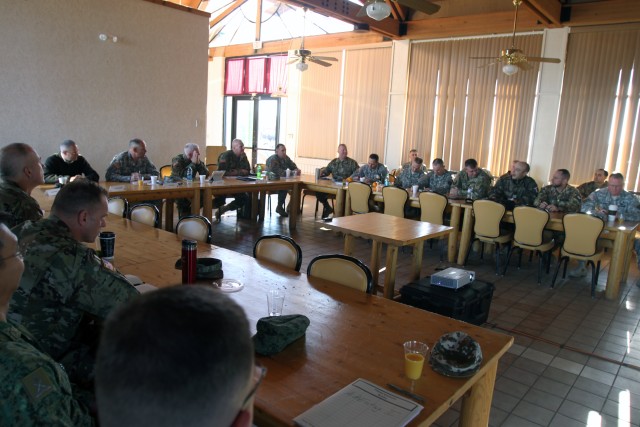FORT SILL, Okla. (Feb. 11, 2016) -- Brig. Gen. William Turner, Field Artillery School commandant and chief of FA, hosted his annual onsite conference Feb. 4, at the Lake Elmer Thomas Recreation Area Lodge.
The meeting was to note branch accomplishments the past year, and to discuss the branch's needed adjustments for this year and beyond.
About 40 Fort Sill FA senior officers, command sergeants major, international liaison and exchange officers and civilian leaders here attended the day-long onsite. Joe Gallagher, Fires Center of Excellence and Fort Sill deputy to the commanding general, and Brig. Gen. Keith Klemmer, Army National Guard deputy to the commanding general for FA, also attended.
In his welcome, Turner told the leaders to look at the branch's challenges from a fresh perspective.
"This is a chance for us to focus on where we've been, where we're going ... what we've been able to achieve, what's going well for us, what is not going as well; and where do we need to focus our efforts going forward and where do we need to adapt," Turner said. "I think we need to focus on our ability to listen today, and not be close-minded."
Dr. Krystal Blue, Cameron University assistant professor, was invited to speak about the current young workforce, and managing it through leadership initiatives (see separate story on Army.mil).
German Army Lt. Col. Joerg Presser, liaison officer to the FCoE, was one of two international officers who presented during the morning session.
Presser spoke about his army's capabilities of indirect fire for 2030 and beyond and the German approach to support the fight in a complex world.
"We have the same challenges, the same requirements, the same issues (as the U.S. Army)," he said. "It's that simple."
After hearing the speakers, the leaders then broke off into five working groups with each group addressing one of the commandant's five lines of effort (LoE):
-- Train and educate adaptive and innovative professionals. The 428th Field Artillery Brigade was the lead for this effort.
-- Integrate redesigned division artillery and field artillery brigades in the operational force. The Capabilities Development and Integration Directorate (CDID) was the lead.
-- Modernize the FA force. CDID had the lead.
-- Improve combined, joint and coalition integration. The Fires Targeting Center had the lead.
-- Recruit, assess and retain a quality FA force. The FA Proponent Office took this effort's lead.
Every LoE had existing outcomes.
For example, under the Recruit, assess and retain a quality FA force, the LoEs included, (1) continuous review and realignment of the 13 FA military occupational specialty series; (2) recruitment of the best and brightest field artillery Soldiers for life; and (3) establish skill qualifications test and talent management standards.
For each LoE, group members identified: what was accomplished the past year; what has changed in the operational environment or Army; and what adjustments are required so the end state can be met. They also had to come up with proposed new outcomes, new priorities.
All of the LoEs had the same end state: A modernized field artillery community lead by agile and innovative leaders, who provide tactical overmatch for Force 2025 and beyond through effective integration of precision joint and combined arms fires.
After the break-out session ended, the working groups presented their recommendations to Turner.
Capt. Eric Barton, FA commandant's executive officer, said there was much idea exchange.
"We had excellent dialogue here today," said Barton, who facilitated the onsite. "We discussed all the different elements that go into the branch, and what it takes to be able to push the branch forward."
For the next few days all the raw data generated at the onsite will be molded to modify the field artillery vision, Barton said. Soon, the new FA vision will be announced to branch leaders throughout the Army.




Social Sharing